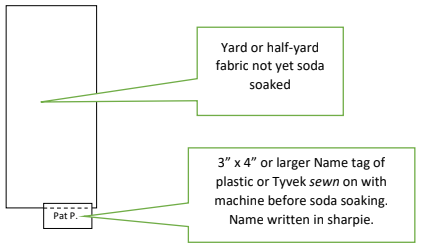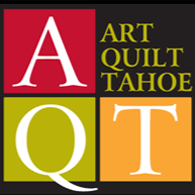Instructor: Pat Pauly
The supply list has been provided by the instructor. If you have any questions, please contact the instructor at patpaulyart@gmail.com.
Supply List
- Old clothes to wear, apron, rubber gloves
- 3 Old towels, cut apart to washcloth size.
- Optional if driving: Bucket or pail, about 2 gallons size is sufficient
- one small (4”) high density foam roller (the type used to paint walls) optional large roller, nappy kind for monoprinting
- 3 wide plastic putty knives, or my favorite – Bondo brand spreaders, used for spreading “bondo” auto resin body filler, are found in the paint department of Home Depot or Lowes
- 9 tall wooden spoons, can be longhandled ice tea spoons – for stirring the dye (need long handles) No Paint Sticks
- Roll of blue masking tape
- Roll of Duct tape for taping silkscreens, or tape meant to tape out silkscreens
- A sharpie marker 10 yogurt or plastic food containers (quart / pint size) 10 sheets of newspaper,
- Scissors to cut cloth
- Piece of cotton batting (need not be new!) 60” x 60” to pad table (under plastic provided)
- Notebook, pencil/pen, camera, phone camera
- 8 or more cut in full or generous yards. (Feel free to bring more like 10-20 yards) of PFD (prepared for dyeing) 100% cotton. I use Test Fabrics #419 or #400M. (Call for prices and availability at testfabrics.com.). You can also soda soak linen and cotton/linen/silk blends that are pfd Dharma may be your source as well for cotton.
Things for printing: 1-2 yards of string, thin plastic premade stencils, cutouts from plastic (under 1/16”). Please just bring a handful – not a boxful!
Notebook of ideas for motif IMPORTANT TO HAVE SOME SKETCHES READY See my Pinterest board https://www.pinterest.com/patpauly/motif-for-surface-design/
Silk screens 4 (or more) 16” x 20” or similar size. (order from Dick Blick http://www.dickblick.com/products/blick-cord-stretched-frame-with-110-monofilament- polyester-mesh/) or purchase $35 from Pat Pauly at the class. Try your luck, or send Pat an email to reserve patpaulyart@gmail.com
Fabric: 15 yards minimum, cut 5 in 1⁄2 yard pieces, leave 10 whole (feel free to bring more like 20 yards) of pfd 100% cotton. I order from Test Fabrics #419 or #400M. Call for prices and availability.
Before Class
Watch the videos on my blog (www.piecesandresistance.blogspot.com) for soda soaking. At the bottom of the blog search for “video” and the videos should come up. (if via your phone, connect to the ‘web page’ version of the blog. The link is here: https://piecesandresistance.blogspot.com/search/label/video
- Add a tyvek tag with your first name and last name written in sharpie. Sew a Tyvek label on the corner. But this has to be sewn on BEFORE SODA SOAKING. You would not want to sew through soda-soaked fabric, as it will damage your sewing machine. Do not pin or staple. Tyvek is a plastic type of mailing material, also used for house wrap in building construction. These tags should hang off one corner, must be larger than 2” x 4”.
- Soda Soak Make ahead of class, soda soak your fabric. Wear gloves for this. In a large bucket add two-gallons water to two cups sodium carbonate (soda ash), add fabric (about 2-3 yards) loosely to this solution and soak 15 minutes or more. Ring out, hang on a line to dry, do not dry in dryer. Continue with small batches until all your fabric is soda soaked. One great tip: after fabric has soaked, place in a sink (or bathtub) to drain a while or overnight, then hang on line to dry. No drip!
- You can make the soda soaked fabric way ahead of time. You can reuse the solution over and over. I’ve stored cotton for a year to wait to use it. So, do a few at a time, not in the washing machine, just in the bucket, drain, hang, store. Note: drying in dryer may cause a fire.
- Note: I purchase my soda ash from pool supply places. I make sure it states “100% soda ash” on the label.
Graphic Notes
Keep a notebook ahead of class of simple forms, shapes, patterns and images that you want to use in your work. You need to have reference for the marks you will be using. Keep a Pinterest board, a box of images, or handful of sketches you can readily access to pull graphics. This is both for jumpstarting your prints, also for starting your OWN mark for a series of prints. Black paper and scissors are a great warmup for exploring the relationship of objects in the composition.
Questions? Email Pat Pauly at patpaulyart@gmail.com
Reserve a silkscreen to purchase in class: email Pat at patpaulyart@gmail.com
To prepare fabric for printing for this class: To see videos on my blog piecesandresistance.blogspot.com, search in the group of words at bottom of blog for “video” to see all the printing videos, and suggestions on how I soda soak.
https://piecesandresistance.blogspot.com/2020/06/how-i-soda-soak-fabric.html
- This is really important! BEFORE SODA SOAKING YOUR FABRIC (step 2) Sew tags with a sewing machine (not pinned or stapled) to your fabric with tyvek (old US mail envelopes, add in sharpie marker your first name and last initial .
These tags should hang off one corner, can be larger than 3” x 4”, but not smaller.
- Soda Soak Make ahead of class, soda soak your fabric. In a large bucket add one gallon warm water to one cup sodium carbonate (soda ash), add fabric loosely (a few pieces at a time) to this solution and soak 15 minutes or more. Longer is ok, so chill! Also, please use gloves for anytime you handle soda soaked fabric, both wet and dry! The soda ash is corrosive to metals like aluminum, but doesn’t effect glass, plastic. It will dry your hands considerably, so wear gloves wet or dry.
- Ring out by hand, hang on a line to dry, do not dry in dryer. Here’s a tip: after soaking, ring by hand slightly, then place in the bottom of a laundry tub or bathtub or shower, or similar (I’ve even used an empty bucket) to let “drain” for a while or overnight, and then when hanging up fabric there is a minimal drip of soda ash solution.
- Smooth by hand and fold. They do relax and are fairly flat. Don’t worry about wrinkles! We’ll talk about how to deal with that, so ironing isn’t necessary.
